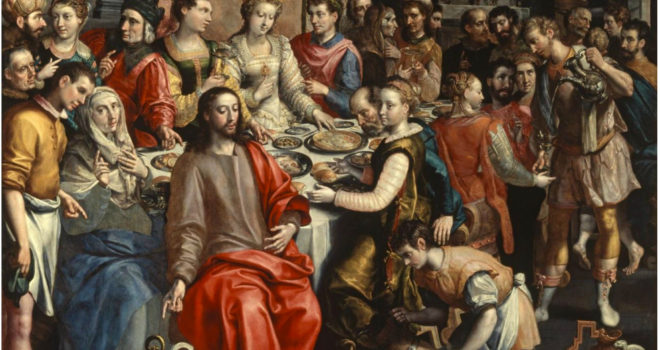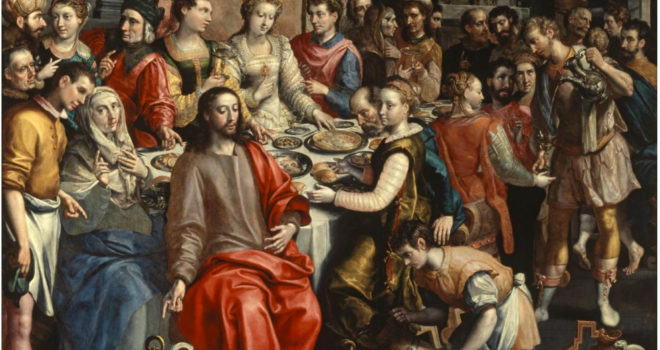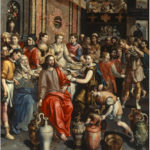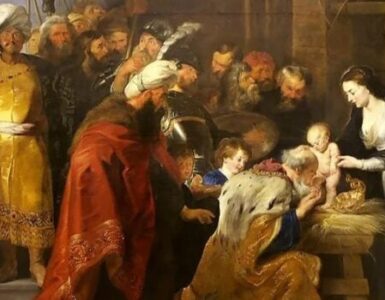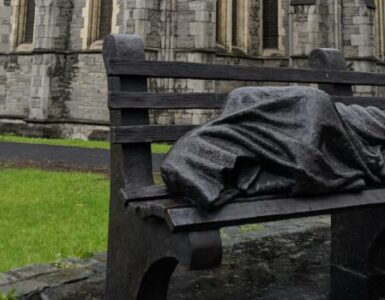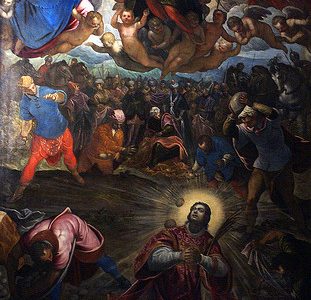Viewing and pondering sacred art offers the faithful a great way to meditate more deeply on the life and ministry of Jesus Christ. This series of articles will highlight several pieces of art related to the Luminous Mysteries of the Rosary, which highlight Our Lord’s public ministry. Each of these pieces of art allows us to reflect on Jesus’ teachings and miracles, connecting them more fully to our own lives.
The Luminous Mysteries were added to the Rosary so that this popular devotion would “become more fully a ‘compendium of the Gospel.’” This set of five mysteries was chosen specifically to help the faithful more fully understand Jesus as “the definitive revelation of God” and the Light of the World (see Rosarium Virginis Mariae, 19). Gazing upon sacred art from throughout the history of the Church that depicts these mysteries can help the faithful achieve this effect more fully and deeply.
The second Luminous Mystery is Jesus’ self-manifestation at the Wedding Feast at Cana. This episode is the setting for Jesus’ first miracle, the first of many miracles to be performed and recorded in the Gospels. At this wedding feast, perhaps more than any other mystery of the Rosary, we encounter the “sacred humanity of the Redeemer,” and we can bring to Him “all the problems, anxieties, labors and endeavors which go to make up our lives” (RVM, 25). That is why this episode is so memorable for the faithful.
In 1597, Flemish artist Maerten de Vos painted The Marriage at Cana. De Vos’s rendition of this biblical event uses memorable details to help viewers connect with the reality of Jesus’ ministry, to help viewers access the light that Our Lord brings to the world and our lives. It is one of the most memorable paintings of this memorable moment in the life of Jesus, and it has much to teach us.
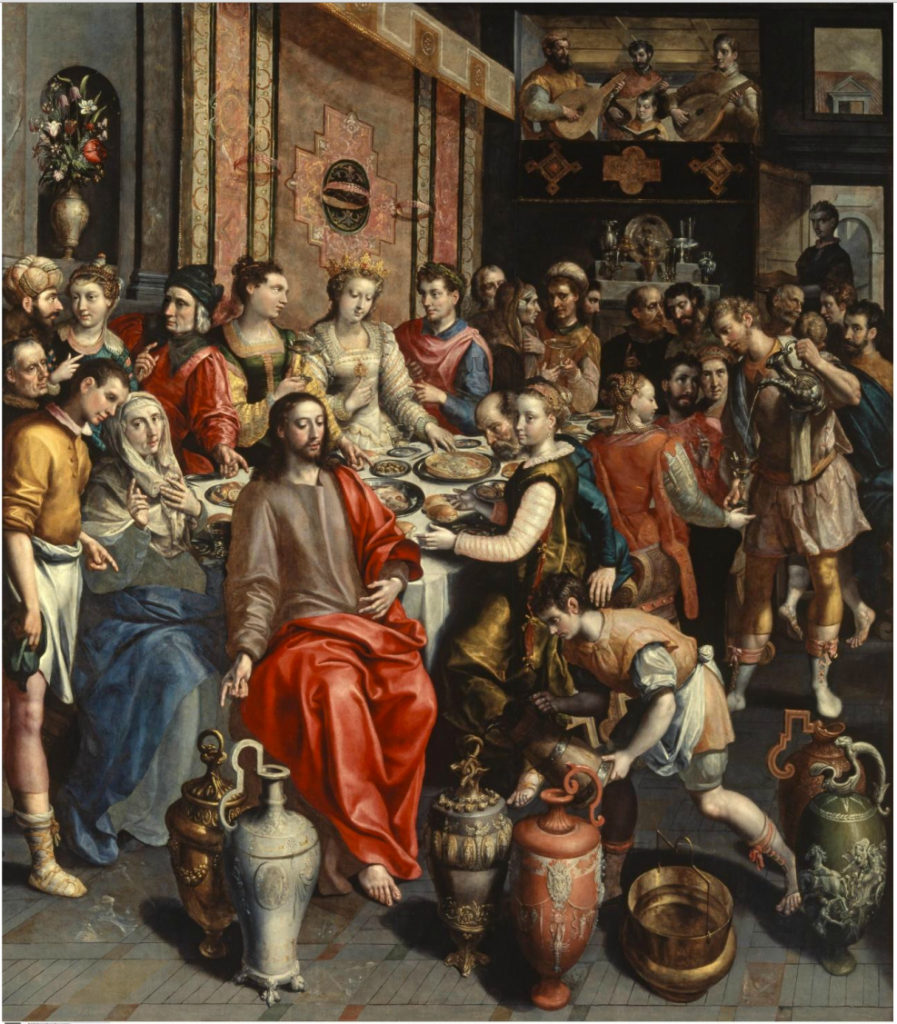
Immediately, a viewer notices the disposition of the crowd in this scene. Nearly every guest at this wedding celebration is looking somewhere other than at Jesus. The people are preoccupied with their own conversations and their own lives. Of course, this would have been natural in this moment, as Jesus had been living in silence and anonymity in Nazareth for nearly His whole life. Still, the fact that the wedding guests were oblivious should elicit a question in each person who views this artwork: Am I going about my life distracted and unaware of Jesus’ presence, even if He is close and is prepared to perform miracles in my life?
While all the other guests are totally engrossed in the food and festivities, there are two guests on Jesus’ left who notice that Jesus is preparing to perform a miracle. One of them, an older man, stares at the Lord with intense incredulity. He seems to say, “I’ll believe it, but I need to see it.” The other is a young woman who is looking directly out of the scene at the viewer while pointing to Jesus with both hands. It is as if she is saying to every one of us, “You need to watch this man. This is going to be really important.” This pair of wedding-goers can help every viewer to ask a self-reflective question: Am I another Doubting Thomas, or am I anticipating the Lord’s action in faith and hope.
Jesus, Himself, is the focal point of the painting. He reclines at table, covered by a red garment. The color of the garment is significant of the fact that Our Blessed Lord’s ministry was inaugurated to culminate in the crucifixion at Golgatha. Ven. Fulton Sheen drew this point out when he wrote that this wedding feast was the beginning of Jesus’ “hour,” the precipice moment that would initiate His pilgrimage to the Cross. So, as we ponder the Wedding Feast at Cana, we ought to remember that relationship with Jesus requires our own via crucis (see Mt. 16:24; Mk. 8:34; Lk. 9:23). But, we also must remember that Jesus walks that Way of the Cross with us.
Next to Jesus is His Blessed Mother, Mary, typically covered in blue. She holds a finger in the air while she talks to one of the stewards of the celebration. This is clearly the moment when she spoke her final recorded words in scripture: “Do whatever he tells you” (Jn. 2:5). So much of the Christian life and spirituality flows from this statement, from the concept of obedience to Jesus. Each and every disciple must take frequent opportunity to examine whether or not he is fully obedient to the Lord, or if there are personal tendencies to distrust and pride.
Then, the steward to whom Mary speaks is also worth a sustained glance. As he listens to this unknown woman, the look on his face seems to say, “Okay, I’m going to do what he tells me. I’m not sure what is going to happen, but I’m really looking forward to seeing something special here.” He also points toward the large carafes of wine, the same place that Jesus points. The fact that both fingers point to the same location illustrates an important trend of the spiritual life. We should want to point in the same direction, to the same place, as Jesus. More than that, we should be fed, sustained, and lifted up by seeing the miraculous works that Our Lord does in the world, even things that might be called “natural” by so many others. Everyday miracles have the potential to keep any of us from being Doubting Thomases.
Finally, there is a Trinitarian motif in this painting. Above the bride and groom, three lute players, along with a young vocalist, providing music for the celebration. The three older men could very well be symbolic of the Trinity. This can help remind viewers of the fact that the Holy Trinity sings joyfully over every holy marriage that is entered into humbly and earnestly. Like the bride, groom, wedding guests, Mary, and Jesus, we all can rejoice in God’s favor upon marriage.
For all these reasons, De Vos’s painting is unique and special. It provides viewers the opportunity to learn or recall important realities about theology and patterns of the Christian life. It also helps bring basic spiritual questions into our minds and hearts. In doing these things, this piece of art allows us to access more of the light by which Jesus wants to illuminate our lives.
Image: The Marriage at Cana by Maerten de Vos is in the public domain.


